Tuesday 26th November 2019

It’s good to see more and more bus companies playing payment systems catch-up by accepting contactless cards as an alternative to cash. I’m not convinced the transaction time is quicker, and indeed could well be slower in the hands of a proficient and experienced cash handling driver, but it’s the way society has rapidly moved and the bus industry must respond and adapt. I very rarely buy anything with cash these days.
My concern is the potential confusion caused by mixing up the simple substitute of cash with a contactless card to buy a bus ticket from the driver with new systems of tap-on and tap-off being rolled out by some operators linked to daily, weekly or even monthly capping. The former is still very much traditional ticket buying; the latter is ticketless travel and sometimes known colloquially as ‘London style’ (ie previously with Oyster).
Before these tapping trials take off too extensively there’s an urgent need for bus companies to think very carefully about how their marketing is targeted, the terminology used and procedures adopted.
In London it has all worked smoothly since the introduction of Oyster to the Capital’s bus network in 2003 because the flat fare has obviated the need to touch out. One tap as you get on is all that’s needed. Everyone accepts the ticketless concept and the daily cap.
Out in the provinces where flat fares aren’t appropriate it’s not so simple. Tap a ticket machine too early and you could end up paying for a single journey whereas you might have wanted a return ticket or a day ticket from the driver. How are you to know the difference?

For example, Brighton & Hove who accept both contactless to buy traditional tickets, and contactless to tap-on and tap-off are using various marketing messages including “Tap to pay and you’re on your way” while Stagecoach South operating through the city accept contactless on their frequent Coastliner route 700 into the city only for buying traditional tickets and use the marketing message ‘Tap & Go’.
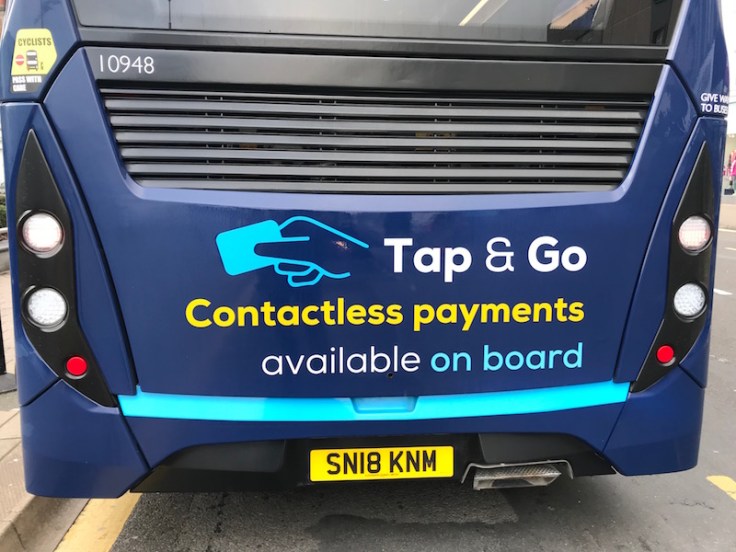
Brighton & Hove also use the message ‘Tap on, tap off. Contactless is even easier’.
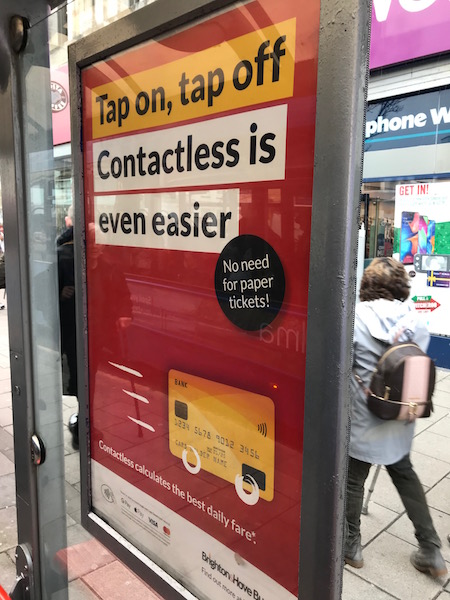
I’m not sure what tap-on tap-off is meant to be ‘even easier’ than …. but an uninformed customer would be hard pressed to know there’s a fundamental difference between the two ‘taps’ – a “Tap & Go” is vastly different to a “Tap-on, tap-off” while a “Tap to pay” could mean anything.
Wellglade owned trentbarton and Kinchbus in Derbyshire and Nottinghamshire both also offer contactless payments and use the terms ‘travel contactless’ (for tap-on and tap-off) and ‘contactless payments’ for buying traditional paper tickets by contactless. TrentBarton have the added complication of also still using their long standing proprietary mango smartcard which has always operated in tap-on and tap-off mode and indeed was the first such operation in the UK – initially offering an attractive 25% discount compared to cash fares but since those heady days has been scaled back to a more modest 10% saving. Mango now suffers from its limited functionality (limited to three timed caps and not possible to offer area zonal caps) compared to what can be achieved through contactless.

The tap-on/tap-off system introduced by Brighton & Hove and Metrobus a few months ago is a good opportunity for Go-Ahead to trial what happens when passengers travel across two bus companies with a common cap. It’s the kind of thing that could be rolled out in Oxford, for example, across two competing bus companies (Oxford Bus and Stagecoach Oxford) with an integrated ticket scheme where the daily cap would effectively be that city’s Smartzone day ticket at £4.30.
Up until now, as a passenger, once I’d bought my Smartzone day ticket, I would know which operator I’d bought it from, and I have no interest in how the money is shared out between Oxford Bus and Stagecoach Oxford. Why would I need to know about that? But in the new world of tapping on and off, this becomes an issue as I found out on my recent trials travelling with Brighton & Hove and Metrobus.
Brighton & Hove have day tickets/daily caps of £5 (travel across the City network) and £7 (travel beyond the City). There’s also a £7.50 Metrovoyager ticket which includes all B&H and Metrobus routes and is quite a bargain if you use it extensively, but I doubt many folk use both Metrobus and B&H that much. Metrobus also have day tickets within each town served as well as across their network.
I was interested in how it would work by making journeys across both B&H and Metrobus which would be subject to the £7.50 Metrovoyager cap, so last Thursday, 21st November I set off for Brighton to give it a try out.
My first journey was from Hurstpierpoint into Brighton on Metrobus route 273. I tapped in as I boarded and tapped out as I alighted. As you tap out there’s nothing to confirm what you’ve paid (as happens when you tap out with Oyster at an Underground gate) – just an ‘accepted’ message.
I happen to know the single fare for the journey I made is £3.70, but otherwise I’d not have known that’s how much debt I’d incurred.

A little concerning was the pole mounted exit reader had gone to sleep as I came to get off in Brighton with no green light displaying. The driver said to use his cab mounted machine instead but just at that moment the former machine came to life and displayed ‘accepted’ as I placed my contactless card on it.
Normally a passenger making a return journey from Hurstpierpoint to Brighton and back would ask the driver for a return ticket which costs £5.90 – a saving of £1.50 compared to buying two singles (at £3.70 each way) for £7.40.
But for that I’d need to know not to immediately tap on to the ticket machine but instead ask the driver for a return ticket in the traditional way, wait for it to be keyed into the ticket machine and then tap my card for the fixed payment to go through and receive a paper ticket. Tap too soon and I’d be £1.50 worse off as the driver would be unable to cancel the £3.70 lined up to be deducted from my bank account; and when I returned home it would be another £3.70 as the tap-on and tap-off system is not clever enough to cap fares paid from and to the same origin/destination at the return fare. Effectively it’s either singles or day tickets in this new world of contactless – tap-on and tap-off may be ‘even easier’ but it could also be ‘even costlier’.
Once I’d arrived in Brighton I took a short ride on a Brighton & Hove bus through the central area with my tap-on and tap-off card clocking up a fare of £2.20.
My third journey was a return trip to Hurstpierpoint which the tap-on and tap-off would calculate as another £3.70 single but I was expecting the Metrovoyager cap of £7.50 to kick in limiting my payment to £1.60 (£3.70+£2.20+£1.60=£7.50).

I eagerly logged on to the Metrobus website when I got home to see if that is indeed what had happened only to get a message ‘no records found’.
I realised I was probably being premature and left it until the next day (Friday 22nd) and had another try.

Somewhat disconcertingly a similar message of no entries matching my ‘search criteria’ came back both when entering my credit card details on the link for unregistered users and, after registering as a user and trying that way. Still nothing. On the upside no transaction had been recorded against my credit card for the previous day’s travel either.
I tried again 48 hours later (on Saturday 23rd) and still nothing as a registered user.
However by checking as an unregistered user up came an entry showing a deduction of £5.30 for Friday 22nd (the day after I’d made the journeys on Thursday 21st).
This puzzled me at first as I couldn’t see why a daily cap would kick in at £5.30 rather than the £7.50 I was expecting; however, when clicking on the icon for further details I then saw the two entries for my outward journey for £3.70 and return journey shown as £1.60.

That’s when it dawned on me that the missing £2.20 (£7.50 less £5.30) would no doubt be listed on the Brighton & Hove website and sure enough, although nothing was showing at that time, later on during Saturday, it popped up as a record – also showing the incorrect travel date as Friday.

Clicking on the ‘Details” icon brought up that journey on route 49 for £2.20.

I checked my credit card transactions again with my credit card company and the Metrobus entry for £5.30 had been deducted and after another 24 hours (on Sunday 24th) the £2.20 was shown as a deduction for Brighton & Hove.
This all seemed a bit confusing to me, and the lack of information being available for 48 hours giving rise to consternation and not helpful in building trust into the system. One of the key elements of ticketless payment systems of this kind, as TfL always point out with Oyster and their use of contactless, is how absolutely vital it is for passengers to trust the system to charge the best fare. Whilst it did do that for my trips, I’m not convinced the presentation across two bus company websites is the best way to show it. Had I bought a Metrovoyager from the driver of the 273 for £7.50 on my first journey I wouldn’t be knowing B&H got £2.20 of this and Metrobus £5.30; indeed the whole £7.50 would have gone to Metrobus and been retained by them.
Following that expereince, I thought I’d give the system another try and so this morning began my tapping in central Brighton and made four short journeys in quick succession.

The first £2.20 centre-fare journey was on a B&H smart new electric bus on route 5B from Preston Circus down to London Road shops.

Short journey number two, just to add to the confusion, was on a Metrobus route 272 from London Road shops to the Old Steine. Although this journey is charged at £2.20 in line with B&H’s fares, and although Metrobus and B&H are effectively run as one company, this journey wouldn’t have been possible with a Brighton & Hove one day City Saver ticket for £5 – only the Metrovoyager £7.50 ticket includes both Metrobus and B&H buses, so I’m not expecting this journey to count towards the daily B&H cap of £5 when it comes to analysing my contactless tap-on and tap-off journey record.

My third shop hop was on a B&H route 1 from the Old Steine just one stop further on in North Street which counts as a £2 ‘short hop’ rather than the £2.20 centre fare, although I couldn’t find a list online showing where these slightly cheaper fares apply.

The fourth and final short hop was on a B&H route 49 from North Street to Churchill Square, which could be £2 or maybe £2.20, but as the £5 cap should kick in I’ll never know!
I’m expecting the B&H £5 cap to cover my three B&H bus fares and the Metrobus £2.20 to be set against the extra £2.50 to take my cap from £5 to £7.50 for the Metrovoyager ticket leaving 30p still to use.
After my four short hops I headed back from Brighton to Hassocks and Hurstpierpoint on a Metrobus 273 which would normally be £3.70 for the single journey, as explained earlier, so I would expect to pay just the 30p outstanding within the £7.50 cap for that journey.
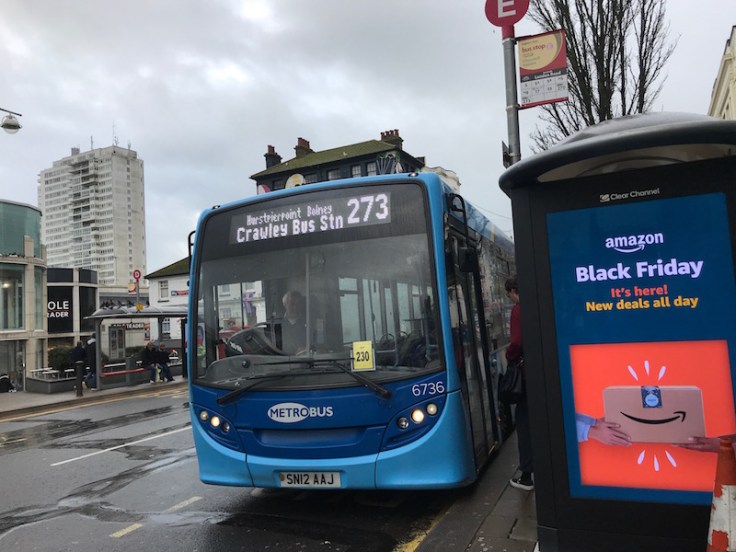
This evening, I’ve checked both the Metrobus and B&H websites to see if my travels have been recorded yet, and much to my surprise following last week’s posting delays, four of my five journeys have appeared. The fifth, that £2.20 journey on Metrobus 272 seems to have disappeared.
On the B&H website using the non-registered user function, it shows the three journeys I made (on routes 5B, 1 and 49) with the £5 daily cap kicking in. (As you can see my journey on Thursday 21st November is still erroneosly listed as Friday 22nd November).

On the Metrobus website using the non-registered user function, it shows only my journey back to Hurstpierpoint on route 273 valued at £2.50 (the difference between the B&H cap of £5 and the Metrovoyager ticket cap of £7.50. The £2.20 journey on route 272 has disappeared into the ether.

When I click on to My Account to see a record of journeys, it still tells me there are no entries to be found.

Update insert: Wednesday 27th November
Checking my transactions record on the Metrobus website this morning (below) I see the elusive journey I made yesterday on route 272 is now listed but showing a zero value being within the £7.50 cap even though the journey was made sequentially earlier than the later journey on route 273 which is given a value of £2.50. Even more confusingly the date of both journeys has now changed to today’s date rather than yesterday!
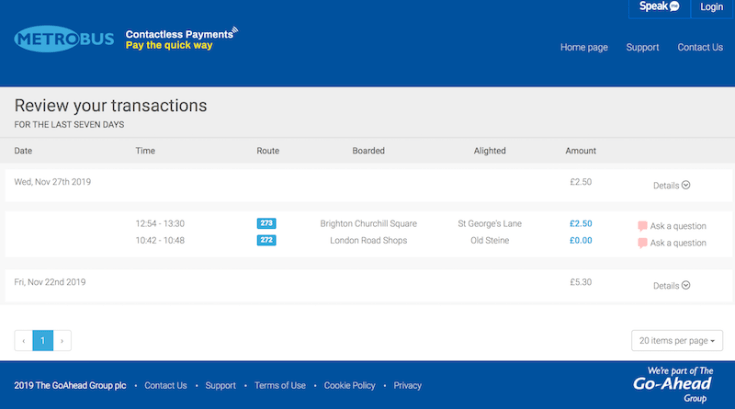
Also, this morning (Wednesday) on checking the ‘pending transactions’ with my credit card company on their online website, an entry for “Brighton & Hove Bus An Brihgotn & Hogbr” appeared for 10p and an hour later a similar entry for Metrobus, although with no gobblegook spelling. I’m told on Twitter these are verfication deductions, but it seems odd (a) to have one from both companies; (b) that I had none last week and (c) they’re both still showing this afternoon, seven hours after first appearing with no sign of the actual expenditure appearing.

Update insert: Friday 29th November
The 10p entries highlighted above were deleted from my credit card statement after 24 hours and finally today the entries for my travels on Tuesday 26th November have appeared – dated 28th November, but only appearing this morning, three days after travelling.

I’m pleased to see my former Company in the vanguard of using this new technology and well done to all involved in setting it all up which I can imagine must have entailed a lot of hard work, but it would seem there are teething problems to sort out, especially how the system works across two companies, which will be critical for those areas where pundits want to see “integrated London style ticketing”.
There’s also wider issues for the bus industry as to how paying for travel is going to be communicated and marketed in the future. Are return tickets old hat; will it all be tap-on and tap-off with daily caps? If so, what about all those who don’t have or don’t want to pay with a bank card? Or those bus companies mainly running trunk routes where daily caps are not appropriate? Will maintaining a range of alternative systems and ticket options add to confusion? What is the difference between “Tap to Pay”, “Tap & Go” and “Tap-on and Tap off”?
There’s a lot to think about, and in the meantime there’s a risk confusion leads to passengers giving up.
Good luck to cities and towns with more than one operator like Oxford in sorting this out in ways passengers will understand, and importantly have the trust and confidence to use.
London Oyster style this isn’t.
Roger French

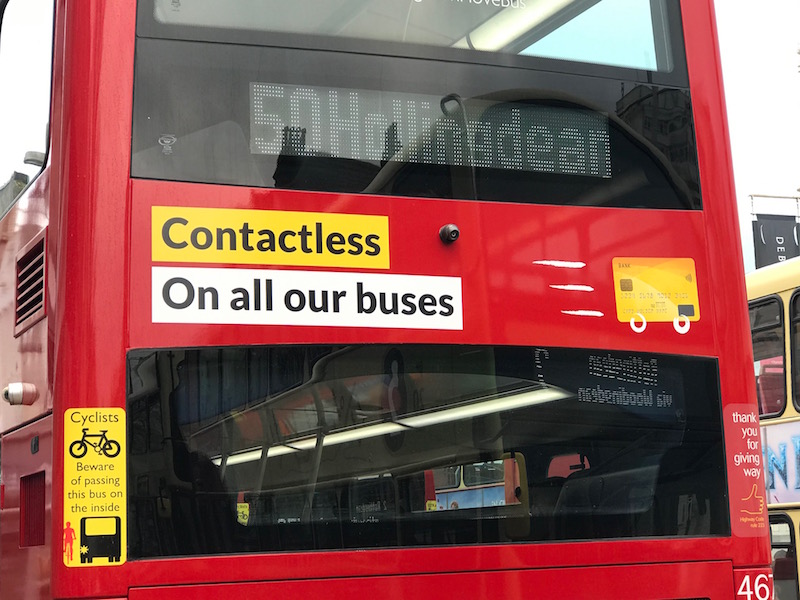
I use my local buses a lot (First Bus Solent Ranger Services 4/5) and there is no doubt that since Ticketer contactless card payment has been introduced boarding times have been reduced and cash payments are now minimal.
Don
LikeLiked by 1 person
Here in Cardiff both NAT and Cardiff Bus use Ticketer. Where cash fares are concerned, NAT gives change while Cardiff Bus uses fare boxes and doesn’t give change. My perception is that cash on Cardiff Bus is quicker than contactless (and that’s assuming that the card is accepted first time, which isn’t always the case), however contactless is faster than a driver giving change – although NAT use this as a marketing point.
As far as over-60 concessions are concerned Cardiff Bus is slower than NAT as they alone issue a ticket with the transaction. However the fastest way to way by way is when people use the Cardiff Bus app on their phones; this shows a QR code to the machine and no ticket is issued. Other options (eg the “Diff” Card) are also available. I would say that fewer than 20% of passengers pay cash on Cardiff Bus, slightly more on NAT which has fewer payment options. Of course, casual passengers are the most likely to pay with cash (and to not know the fares!)
LikeLiked by 1 person
No one should be worse using tap on tap off, but many operator websites say ‘don’t use it if you would buy a return’, this might be a system limitation which needs to be sorted otherwise the ‘best price guarantee’ and avoiding the need to know the ticket range benefits are lost. Not including a weekly cap seems to be an operator choice, which seems unfair. Working with supportive operators on this in Portsmouth at the moment. It certainly seems worth getting right to make travel simpler for traditional non users but not quite there yet.
LikeLiked by 1 person
Wow! That took some following Roger, and still not sure my old brain actually took it all in, but you have certainly thrown up the many possible pitfalls and inconsistencies that these new systems have produced. I am sure some of this will eventually be overcome given time. But on the plus side, I have noticed that as card payments are increasing, rapidly in some areas, and the initial stumbles/unfamiliarity have been sorted, the system is definitely improving boarding times. And another big “plus”, which would have been nice NOT to have to record, is less “forgetting” by some Drivers (usually on small Operators services) to actually issue the ticket after the cash transaction. Sadly, something I have seen increasingly of late. A card transaction does it for them!
LikeLiked by 1 person
Being Brighton based I’ve used Tap on Tap Off a lot, in fact I was the very first person to use it having been invited to trial it by B&H before it went public. There are certainly issues with charges not relating to the correct day but I’ve found recently most charges appear very quickly, within minutes. I don’t think I’ve ever been overcharged overall. The tap off readers are set to turn off between stops to prevent passengers tapping off too soon to get a cheaper fare but I agree this can be confusing. I find tapping off is not intuitive, I usually keep my card in my hand when I’m on the bus and I reckon many people either forget or don’t bother tapping off. Fine on short city routes when the City Saver cap kicks in but not so good if you are charged from Brighton to Eastbourne. It was a bold decision to proceed with this system and I hope it is a success as they are a great team at B&H/Metrobus (as always Roger!), Unfortunately I feel the current publicity posters muddle the distinction between straightforward contactless payments and Tap on Tap Off.
LikeLiked by 1 person
One wonders if this technology will drive bus operators towards the London rail/tube pricing model where day return tickets were abolished and single fares adjusted to be half the value of former return (with peak and off-peak variations in most cases)
LikeLiked by 1 person